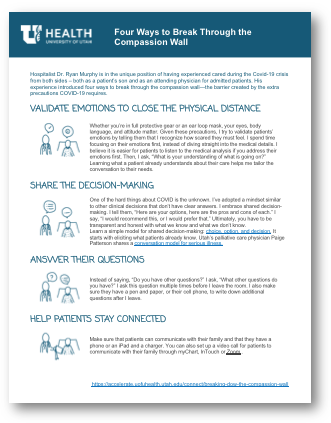Learning Objectives
1) Relay each step of SPIKES
2) Identify when to use SPIKES
3) Apply SPIKES to keep the conversation on track when delivering bad news
COVID-ready communication skills: A playbook of VitalTalk Tips
VitalTalk, the nonprofit health care communication resource group who develops many high-emotion health care communication frameworks, has created a real time guide for communicating with patients, peers and the public about the coronavirus. Visit the COVID-19 scripts, online training and direct updates here.
edical training is full of mnemonic devices—quick techniques that help us remember what to do.
Need a technique to help keep lines of communication open and reduce tension? SPIKES is an easy mnemonic any health care professional can use to deliver bad news to a patient, fellow team member or visitor.
SPIKES stands for:
- S – Setting
- P – Perception/Perspective
- I – Invitation
- K – Knowledge
- E – Empathy/Emotion
- S – Summary/Strategy
The Impact of SPIKES Communication
SPIKES can be used in numerous situations to deliver bad news, from a new diagnosis to a medical error. It provides a structured, easy way to enter a conversation and allow the other person, whether it is a patient or one of their family members, to have whatever reaction they need to have in that moment.

Hospitalist Ryan Murphy recently shared his experience as a doctor and the son of a COVID-19 patient. Learn how he breaks down the barrier created by the extra precautions PPE and social distancing requires.
Download the Four Ways to Break Through the Compassion Wall 1-page quick tips.
For health care providers, SPIKES may be used daily or even multiple times per day. Especially now, in the time of COVID-19, you may need to use SPIKES frequently to speak honestly and sensitively to the people you are caring for. By using this structure for your conversation, you can feel more confident in your ability to communicate clearly and empathetically, even in the worst situations.
How to Use SPIKES
If you have a situation where you are delivering bad news, follow the SPIKES framework for empathetic conversation.
S - Setting
First, choose the right setting and time to speak to your patient, visitor or coworker. That usually means a time when you can speak to them as long as they need and won’t be rushed out of the room. You should also ensure the room is private and that you won’t be interrupted during your conversation. Tell other staff members that you need privacy so they can steer clear of the area.
Next, make sure that everyone who needs to be present is present. You may want other care team members with you or you may want to ensure that a patient has a support person with them. Before you begin delivering the news, make sure proper introductions are made with everyone in the room. Then take a seat so both you and the people you are speaking to feel more comfortable.
P - Perspective/Perception
Once you are in an appropriate setting, you need to assess what the person knows about the situation. For instance, you may ask questions like:
- What do you know about your illness?
- Do you know why Dr. Smith sent you here?
- How do you think your illness will affect you?
- Tell me what you know about your mother’s health.
These questions help give you a baseline for how the patient, or their family, feels about their condition and how they might react. You may find that the patient is in denial about the seriousness of their illness or that they don’t have a good understanding of their health.
I - Invitation
You will then need to determine how much the patient or their family wants to know about their situation. Patients have the right to know or not know certain things about their condition. They may only want broad strokes, but no details. Other patients will want to know everything possible about their illness and treatment.
To find out what your patient wants, simply ask questions like:
- Would it be helpful for you to know what to expect from here on out with your illness?
- Would it be OK if we talk about some serious issues with your care?
- We have these lab tests back. Can we talk about them?
K - Knowledge
Once you understand the level of information your patient wants, it is time to deliver the news and teach them about their health. No matter how much information you are giving them, you should keep terms simple and be direct. Don’t use euphemisms, but don’t be excessively blunt either.
You can give patients a quick heads up that they are going to hear bad news with a “warning shot.” You might say things like:
- The situation may be a little more serious than that.
- This may be more serious than we originally hoped.
Give them information in small chunks, then pause to give them time to digest the information or ask questions. You can also check in with them to see if they are processing the information how you are delivering it by asking if you are making sense. Repeat any important points to ensure the patient can put the information together.
E - Empathy/Emotion
While sharing information, you also need to be empathetic. Some patients will have an emotional response, others won’t. There’s no way to predict how your patient will feel.
If you patient does react strongly, you can use NURSE skills to help patients with strong emotions like anger and depression. Help them name and normalize how they feel, respect their emotions and help support them.
S - Summary/Strategy
Support is also the last step of SPIKES. Use simple and clear statements to let them know they have a whole team on their side to help and that they won’t be alone throughout their care. You can work with them to develop a plan for moving forward and answer any questions they have.
Conclusion
SPIKES can be used in numerous situations to deliver bad news, from a new diagnosis to a medical error. It provides a structured, easy way to enter a conversation and allow the other person, whether it is a patient or one of their family members, to have whatever reaction they need to have in that moment.
Claire Ciarkowski
“This is why I went into medicine—to talk to my patients and show them humanity.” In the rapid day-to-day clinical setting, that’s harder to find. Utah Advanced Communication Training (UACT) provides practical tools to enhance patient and peer interactions.
It’s been quite a year—but we made it! The Accelerate Team is celebrating the small wins with some big engagement from across the globe. Thank you to all 158 contributors who shared valuable insights with the U of U Health community in 2021.
Your gut tells you a process could be better than it is—how do you back that feeling up with hard data? Senior value engineer Luca Boi shows how undertaking a baseline analysis can jumpstart your improvement project.
